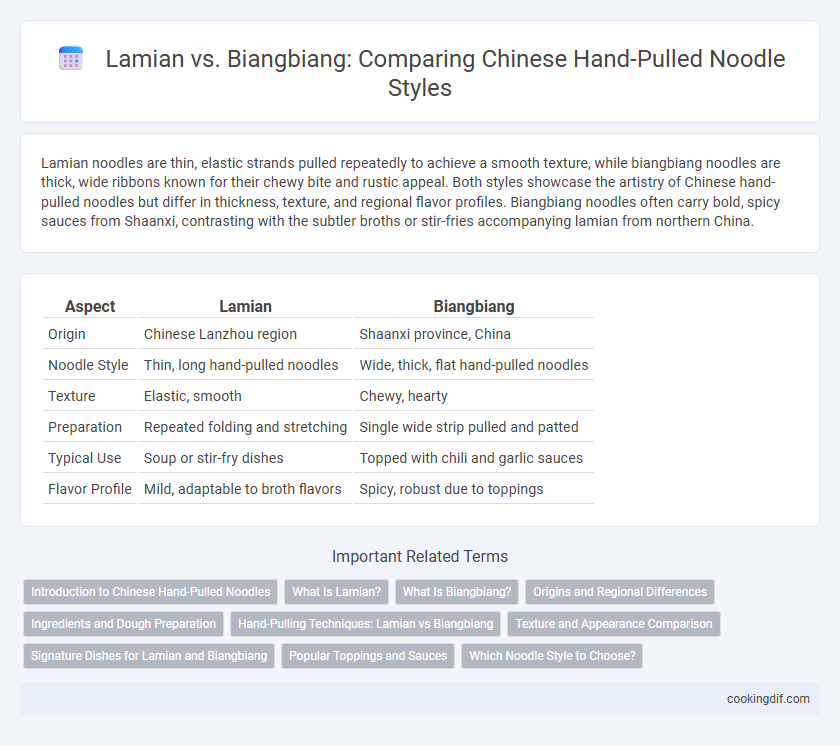Lamian noodles are thin, elastic strands pulled repeatedly to achieve a smooth texture, while biangbiang noodles are thick, wide ribbons known for their chewy bite and rustic appeal. Both styles showcase the artistry of Chinese hand-pulled noodles but differ in thickness, texture, and regional flavor profiles. Biangbiang noodles often carry bold, spicy sauces from Shaanxi, contrasting with the subtler broths or stir-fries accompanying lamian from northern China.
Table of Comparison
| Aspect | Lamian | Biangbiang |
|---|---|---|
| Origin | Chinese Lanzhou region | Shaanxi province, China |
| Noodle Style | Thin, long hand-pulled noodles | Wide, thick, flat hand-pulled noodles |
| Texture | Elastic, smooth | Chewy, hearty |
| Preparation | Repeated folding and stretching | Single wide strip pulled and patted |
| Typical Use | Soup or stir-fry dishes | Topped with chili and garlic sauces |
| Flavor Profile | Mild, adaptable to broth flavors | Spicy, robust due to toppings |
Introduction to Chinese Hand-Pulled Noodles
Chinese hand-pulled noodles, such as Lamian and Biangbiang, showcase distinct regional techniques and textures. Lamian, originating from Northern China, features thin, elastic strands created by repeatedly stretching the dough, resulting in a chewy bite ideal for soups and stir-fries. In contrast, Shaanxi's Biangbiang noodles are broad, thick, and flat, offering a hearty, rustic texture often paired with bold, spicy sauces that highlight the noodle's robust surface.
What Is Lamian?
Lamian is a traditional Chinese hand-pulled noodle known for its thin, elastic strands created by repeatedly stretching and folding dough. Originating from northern China, lamian is prized for its smooth texture and ability to soak up rich broths and sauces. Unlike biangbiang noodles, which are wide and chewy, lamian emphasizes delicate thickness and uniformity, making it a versatile staple in Chinese cuisine.
What Is Biangbiang?
Biangbiang noodles, a signature hand-pulled style from Shaanxi province, are known for their wide, thick ribbons and chewy texture, distinguishing them from the thinner, more elastic Lamian. The unique name "biangbiang" mimics the sound of dough slapping against the counter during preparation, highlighting the traditional technique's auditory element. These noodles absorb bold, spicy sauces well, making them a favorite in Chinese cuisine for robust, flavorful meals.
Origins and Regional Differences
Lamian, originating from northern China, especially Lanzhou, features thin, elastic strands crafted by repeatedly stretching and folding the dough, reflecting the Uyghur and Hui culinary influences in the region. Biangbiang noodles, from Shaanxi province, are characterized by their wide, thick ribbons and slightly chewy texture, embodying the robust flavors and rustic cooking techniques of northwestern China. These regional differences highlight northern China's diverse hand-pulled noodle traditions, with Lamian emphasizing delicate craftsmanship and Biangbiang showcasing hearty, bold characteristics.
Ingredients and Dough Preparation
Lamian dough is made from wheat flour, water, salt, and requires extensive kneading and resting to develop gluten that allows for its characteristic long, thin strands. Biangbiang noodles use a similar flour base but incorporate oil and a slightly higher water ratio, resulting in thicker, broader, and chewier noodles. The dough preparation for biangbiang involves stretching and slapping techniques distinct from the repetitive pulling of lamian, highlighting regional variations in hand-pulled noodle methods.
Hand-Pulling Techniques: Lamian vs Biangbiang
Lamian noodles are crafted using a continuous stretching and folding technique, creating long, thin strands that emphasize elastic texture and uniform thickness. Biangbiang noodles involve a dynamic slapping and pulling motion, producing wide, thick ribbons with a chewier bite and rustic surface texture. Both hand-pulling methods highlight regional differences in dough composition and manipulation, shaping distinct culinary experiences within Chinese noodle traditions.
Texture and Appearance Comparison
Lamian noodles have a smooth, elastic texture with a uniform thickness achieved through repeated stretching, resulting in a glossy, cylindrical appearance. Biangbiang noodles are much broader and flatter, featuring a chewy yet slightly rough texture and a rustic, uneven surface that allows sauces to cling better. The textural contrast between Lamian's silky bite and Biangbiang's hearty chew contrasts distinctly in both mouthfeel and visual presentation.
Signature Dishes for Lamian and Biangbiang
Lamian features signature dishes like Lanzhou Beef Noodles, renowned for its hand-pulled, thin, and chewy strands served in a clear broth with tender beef and herbs. Biangbiang noodles stand out with their wide, thick ribbons, often served with spicy chili oil, garlic, and vinegar, creating a bold, flavorful experience integral to Shaanxi cuisine. Both styles highlight the artistry of hand-pulling dough, but Lamian emphasizes delicate texture while Biangbiang focuses on robust, hearty flavors.
Popular Toppings and Sauces
Lamian features popular toppings like sliced beef, bok choy, and wood ear mushrooms, often complemented by a savory soy-based sauce with garlic and chili oil for a rich, umami flavor. Biangbiang noodles, known for their wide, thick texture, are commonly served with spicy chili oil, soy sauce, garlic, vinegar, and topped with ground pork, scallions, and pickled vegetables for a bold, robust taste. Both styles highlight hand-pulled craftsmanship but differ significantly in their texture and sauce profiles, offering diverse experiences in Chinese noodle cuisine.
Which Noodle Style to Choose?
Lamian noodles feature thin, elastic strands with a smooth texture, ideal for absorbing rich broths, while biangbiang noodles are wide, chewy, and often thicker, providing a hearty bite perfect for bold, spicy sauces. Choosing between lamian and biangbiang depends on the desired texture and flavor profile; lamian suits delicate, light soups, whereas biangbiang complements robust, savory dishes. Both hand-pulled styles showcase distinct regional techniques, highlighting nuanced differences in noodle thickness, stretchiness, and culinary application.
Lamian vs biangbiang for Chinese hand-pulled styles Infographic

 cookingdif.com
cookingdif.com